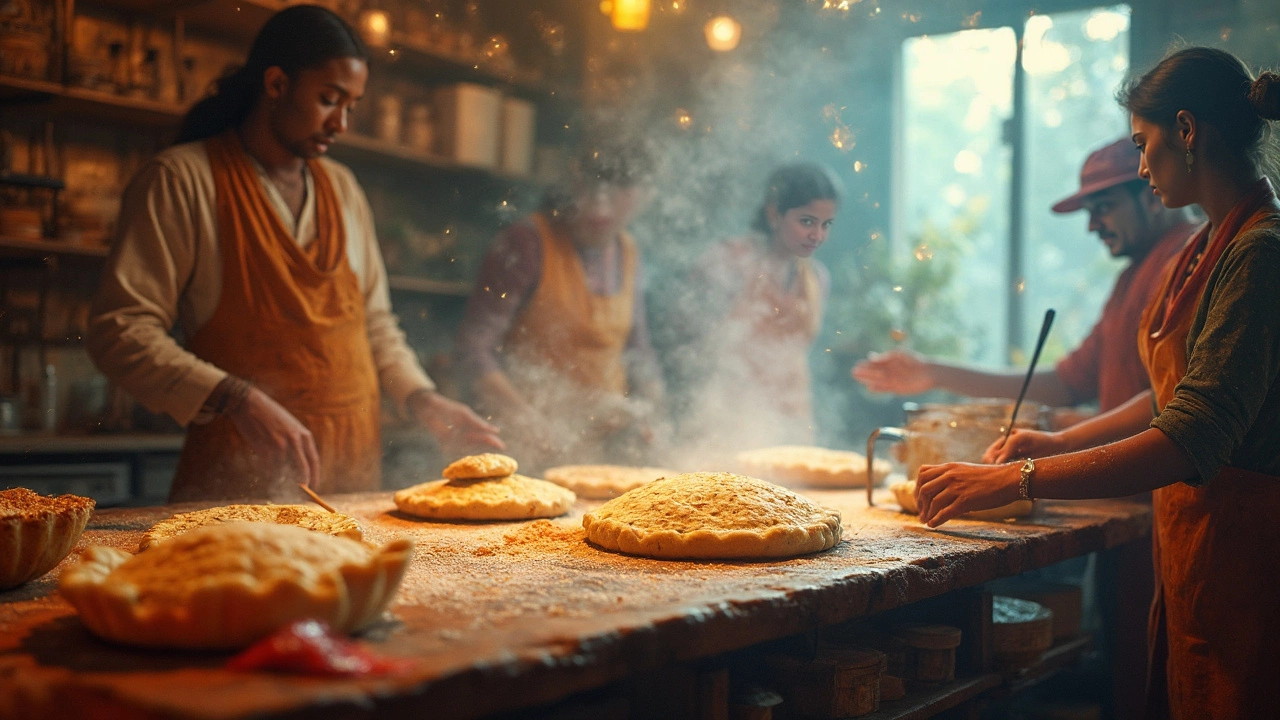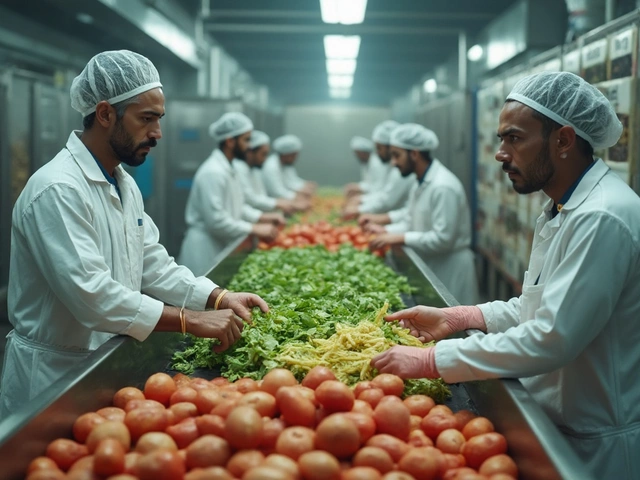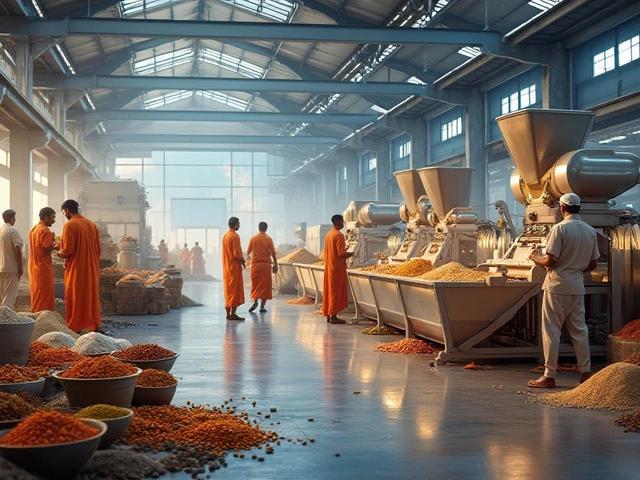When we think about our favorite foods, it’s easy to overlook the intricate processes that bring them to life. One such vital process is 'forming' in food processing. It’s not just about mixed ingredients; it’s all about crafting those ingredients into shapes that are familiar and desirable to us.
Forming is everywhere, from the perfectly round burger patties flipping on a grill to the consistent spiral of pasta. It’s the magic skill turning raw mixes into uniform, attractive products ready to be chomped down.
Why does it matter? Well, looks sell! And let’s be honest, food looking good is half the appetite battle won. But it’s not just aesthetics. Consistent shapes make cooking more even, which can directly affect taste and texture. That juicy burger patty? Thank forming for its perfect cook through.
In the following sections, we'll explore popular methods like molding, extrusion, and more. These techniques transform otherwise formless mixes into the eye-catching eats we find in stores and restaurants. Plus, we’ll sneak a peek into the future of forming—to see how emerging innovations are reshaping (literally) the food industry.
- Understanding Forming in Food Processing
- Why Forming Matters
- Popular Forming Techniques
- Innovations in Forming
- Challenges and Solutions in Forming
- Tips for Optimizing Forming Processes
Understanding Forming in Food Processing
When it comes to food processing, forming is one of those essential steps that works behind the scenes ensuring our meals look as good as they taste. But what exactly is forming? Simply put, it's the process of shaping food into desired forms using various techniques and machinery.
How Does Forming Work?
The concept is straightforward: take raw ingredients and transform them into uniform shapes. While it might sound simple, it involves complex machinery and technology. Different foods require different forming methods, depending on their texture and composition.
Common forming techniques include extrusion, which uses a high-pressure system to push food through a mold. You've probably eaten snacks or cereals that were born from this method! Another common method is molding, particularly popular for creating candies and baked goods, where food materials are pressed into specific shapes.
Tools of the Trade
The equipment used in forming varies, but typically you see machines like patty formers for burger production, or wire-cut machines for bakery items. These machines offer precise control over weight and size, which is crucial for consumer satisfaction and cooking performance.
Importance of Forming
Why is forming such a big deal? Consistency and efficiency. Having uniform pieces means every bite offers the same experience. Plus, it eases the cooking process, ensuring everything cooks at the same rate.
Fun Fact
| Forming Method | Application |
|---|---|
| Extrusion | Cereals, snacks |
| Molding | Candy, baked goods |
| Slicing | Cheese, deli meats |
Understanding forming not only gives us insight into how our favorite foods are made but also underscores the innovation at play in today's food industry.
Why Forming Matters
When it comes to food processing, forming isn't just a step in the production line—it's a crucial player in the game's outcome. Imagine a world without even-sized hamburger patties or the neatly cut doughnuts we munch on for breakfast. Forming brings order to chaos in the food world, and here's why it's a big deal.
Consistency is Key
Firstly, forming ensures consistency. Whether you're frying, baking, or packaging, uniformity plays a huge role in quality control. Think about it: if every piece isn't the same size, how can you guarantee it cooks evenly? The food industry relies heavily on forming techniques to deliver that consistent quality we expect from our favorite brands.
Think Beyond Looks
It’s not all about aesthetics, though. Sure, appearance matters (nobody wants a lopsided artisan bread), but forming also impacts the functionality. For example, pasta shaped uniquely can hold sauce differently, changing the taste experience. In a fast-paced world, even cooking times gained through uniform forming can be a big win, saving energy and time.
Efficiency and Waste Reduction
Forming also tackles the efficiency factor. By optimizing how food is shaped, production can run smoother, faster, and with less waste. That’s less excess dough or meat mix going in the bin and more savings for producers—savings that can get passed down to the consumer.
| Impact | Description |
|---|---|
| Consistency | Ensures even cooking and presentation |
| Efficiency | Reduces waste and speeds up production |
| Innovation | Allows for new food experiences through shape variations |
Driving Innovations
Finally, let’s not forget the innovation aspect. Forming techniques are constantly evolving, driving new possibilities in product development. From gluten-free bread shapes to plant-based burger patties, forming allows experimentation with new ingredients and structures, catering to ever-changing consumer preferences.
Popular Forming Techniques
In the food processing world, forming is the middle act where culinary art meets engineering. From shaping dough into baguettes to pressing meat into burger patties, these techniques are all about precision and consistency.
1. Molding
One of the oldest tricks in the book, molding is as straightforward as it sounds—placing ingredients into molds to get a specific shape. Think of those candy bars and frozen pizzas. Molding helps get that perfect form with an easy release from tightly designed molds. Even handmade bread uses this idea, albeit with less precision.
2. Extrusion
Extrusion is like magic. It forces a mix through a narrow opening to identify shape pasta, snacks, or even pet food! This one's a favorite because of its ability to control size and density, especially for cereals and similar foods.
"Extrusion's adaptability makes it indispensable in modern food manufacturing," says Dr. Elaine Thompson, a leading food tech scientist.
3. Pressing
Often seen in making burgers and tofu, pressing applies steady pressure to compress food into solid shapes. It's about creating a defined form that holds its own through cooking or packaging.
4. Forming Machines
In today's high-tech world, specialized machines craft consistency and speed. These machines can handle large batches, ensuring each unit gets the perfect treatment. Fancy a perfectly designed sushi roll? That’s a forming machine at work.
5. Co-Extrusion
Ever enjoyed a stuffed breadstick? Co-extrusion allows a filling to be enclosed within a shell, uniting flavors with efficiency. It’s a double act at once.
The list of popular forming techniques goes on, each tailored to specific types of food and production goals. With technological advancements and embracing traditions, the industry continually innovates to meet changing consumer demands without skipping a beat. This balance of tradition and tech keeps our favorite foods both nostalgic and exciting.

Innovations in Forming
The world of food processing is ever-evolving, thanks to cool new tech that's reshaping how we do things. At the heart of this change is the need to make things faster, greener, and a whole lot smarter.
3D Food Printing
Yeah, you heard it right—3D printers aren’t just for making mini models of superheroes; they're doing some wild stuff in the food scene. This technology allows for precision forming of intricate shapes, meaning you can create complex designs without any hiccups. Imagine chocolate sculptures or pasta with built-in seasoning pockets. The sky's the limit!
High-Moisture Extrusion
For the vegan or veggie crowd, this one's a game-changer. High-moisture extrusion allows plant-based proteins to be formed into textures remarkably like meat. The result? Burgers that taste (and chew) like the real deal. It's a major win in making plant-based diets more appealing to the masses.
Robotics in Forming
Robots are stepping into the food industry big time. With their help, forming processes can be super precise and much quicker. Think robots delicately handling dough to create perfect pastries every time or efficiently forming granola bars without human error creeping in.
| Technology | Advantage |
|---|---|
| 3D Printing | Precision design |
| High-Moisture Extrusion | Realistic textures |
| Robotics | Precision and speed |
On top of all this, there's a push towards sustainable techniques that minimize waste. Innovations like these offer not just efficiency, but a roadmap to a more environmentally friendly way of shaping the foods we crave. With each breakthrough, the food industry steps closer to a future where technology and tastiness go hand in hand.
Challenges and Solutions in Forming
The process of forming in the food industry may seem straightforward, but it’s fraught with hurdles. Between ensuring consistency and meeting consumer expectations, food processors have their work cut out for them. Let's dig into some common challenges and discover clever solutions.
Maintaining Product Consistency
One of the toughest nuts to crack in food processing is keeping each product the same as the last—whether it’s a burger patty or a complex pastry. Consistency isn’t just about looks but also impacts cooking time and taste. Companies invest heavily in equipment and quality control systems to maintain this uniformity.
“Inconsistency in product form can lead to variations in cooking performance, impacting consumer satisfaction,” says Dr. Marina Cook, a food technology expert.
To tackle this, many facilities utilize automated systems equipped with precise cutting tools and sophisticated measurement tech. These gadgets ensure each piece matches predefined standards before it hits shelves.
Handling Diverse Ingredients
Different foods bring unique challenges—sticky doughs, for example, can clog up machinery, while delicate ingredients require gentle handling. This means various machine settings and designs are often necessary to accommodate the specific demands of each ingredient.
Solution? Invest in versatile equipment that can adjust to different inputs without a hitch. Many processors opt for modular machines that can switch functions quickly, saving time and costs.
Efficiency in High-Volume Production
High-demand requires not just speed but also efficiency. This is especially critical for meeting orders without compromising quality. The trick lies in balancing speed with precision.
A promising solution involves using advanced robotics and AI technology for real-time monitoring and adjustments. These systems help identify bottlenecks and areas needing fine-tuning, ensuring smoother operations without unnecessary slowdowns.
| Top Equipment Issues | Potential Solutions |
|---|---|
| Sticky Dough | Non-stick surfaces, specialized coatings |
| Inconsistent Sizing | Precision equipment, regular calibrations |
| Mechanical Downtime | Regular maintenance, robust training |
At the end of the day, overcoming these challenges requires a blend of technology innovations, smart management strategies, and sometimes, just a bit of trial and error. But with each tweak and improvement, food processing units become better at shaping the foods we love in the most efficient ways possible.
Tips for Optimizing Forming Processes
Getting the most out of food forming isn't just about having the right equipment. It’s a blend of technique, maintenance, and a bit of innovation. Let’s dive into some practical tips that can make a real difference.
1. Maintain Your Equipment
Regular maintenance is a game-changer. Keeping machines in top shape ensures they perform consistently, minimizing downtime and repairs. Simple things like regular oiling and timely cleaning can keep the forming machinery running like new.
“Consistency is key in forming efficiency. Regular equipment checks can prevent a lot of headaches,” says Emma Carter, a leading engineer in food technology.
2. Optimize Temperature and Pressure
Many forming processes rely on precise temperature and pressure. It's crucial to keep them in check. For example, temperature control can drastically affect the texture of pasta. Sticking to the manufacturer’s recommended settings is often a good baseline.
3. Test with Different Ingredients
Sometimes, small tweaks in ingredient composition can lead to better results. For instance, experimenting with moisture levels can enhance the binding and uniformity of products like burger patties.
4. Implement Regular Quality Checks
Introducing quality control at different stages of the forming process helps catch issues early. This might include visual inspections or using sensors to detect anomalies in the product flow.
5. Stay Updated with Innovations
The food industry is teeming with advancements. Whether it’s new non-stick coating materials or automated shaping tools, staying informed on the latest tech can give you a competitive edge.
Here’s a quick look at some interesting forming stats:
| Aspect | Impact |
|---|---|
| Regular Maintenance | Reduces downtime by 30% |
| Temperature Control | Improves texture consistency by 20% |
Implement these strategies, and you’ll see a notable difference. Keen attention to detail and staying adaptable to new technologies can significantly uplift your food processing game.







Write a comment